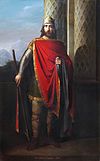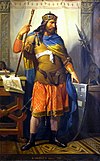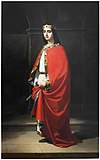Annex: Monarchs of Asturias
Contenido keyboard_arrow_down
See also: Annex:Consortes de Asturias
The monarchs of the kingdom of Asturias were thirteen beginning with Don Pelayo. The monarchy was initially elective but after the death of Ramiro I in 850, his son Ordoño I acceded to the throne without a prior vote. Since then the monarchy was de facto hereditary.
Estatua de don Pelayo en Covadonga
The kingdom of Asturias to the death of Alfonso III the Magnus
Generic tree
Both images have been adjusted to the same height, and to a total width of 350px.
List of monarchs of Asturias
Family tree of the monarchs of Asturias
In the following family tree the following annotation is used:
 , graphic symbol to point to a king.
, graphic symbol to point to a king. , stands out to the kings of Asturias.
, stands out to the kings of Asturias.- Kings carry an indicator of order (p.e., “Rey de Asturias (3.o)», which means he is the third Asturian king; he is a mere indicator, as the Asturian kings have no official order.
- In a line below royalty members, there are several dates in parentheses indicating: year birth-years reigned (in black)-year of death; p.e.: "(?-925-926-932)", refers to a person born on an unknown date, who between 925-926 was a ruler and died in 932).
- - Solid lines point to legitimate descendants;
- - The lines of stripes indicate a marriage;
- ·········· Point lines point to an un legitimized relationship and illegitimate descendants.
Timeline of the Asturian monarchy

Note
- ↑ Use the title Princeps (first citizen or prince) equivalent to leader or leader, used several times before in the history of the region. The Hispanic monarchy begins as well as a simple caudillaje.
- ↑ First sovereign proclaimed Rex (chuckles) However, the Asturian monarchs continue to call themselves indistinctly princes or kings.
- ↑ The young Alfonso II is overthrown and exiled with the Basques, a town from which his mother Munia of Álava came.
- ↑ He abstained after his defeat in the battle of the Burbia River.
- ↑ His reign transcended that was originally nicknamed Alfonso the Great, however, to differentiate it from Alfonso III was started to call the Casto. For example, the use of the title of Rex.
After being forced by a nobility group to retire to the monastery of Ablaña in 801, he managed to regain power seven years later. He immediately begins to link his reign with the idea of being heir to the Visigoth monarchs and to his Spain lost, in this way it justified both its regio power and colonization (presure) that begin to make on their own groups of free peasants, the border begins to advance south due to demographic pressure in Asturias. - ↑ First monarch who agreed to the throne without a vote. Since then the monarchy was de facto hereditary.
- ↑ Privileged King of Asturias after the division of the kingdom among the sons of Alfonso III the Magnus. After the death of his brothers García I and Ordoño II, he was king of Leon between 924 and 925, gathering all the paterna heritage.
Contenido relacionado
Jose Antonio Primo de Rivera
Ramon Berenguer IV of Barcelona
Mexica religion
Más resultados...















